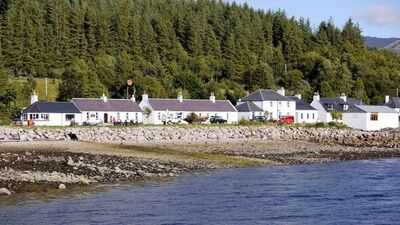Travelling to Inverie, on Scotland's west coast, involves a gradual withdrawal from the usual rhythms of the UK. Tucked away in the Scottish Highlands' Knoydart Peninsula, between Loch Nevis and Loch Hurn, reaching Inverie is deliberately unusual. It is only accessible by boat - there are no roads connecting it to the rest of the country. Most visitors travel from Mallaig, the nearest ferry port, by a passenger boat across Loch Nevis. The crossing takes about 30 minutes, and the ferry schedule is limited. When poor conditions prevent the Western Isles Cruises service from running, there is no other way to enter or leave the village, meaning many have got stuck.
The MV Western Isles also runs a ferry service to Inverie, but only on weekdays and between April and October. For those who prefer to reach the village on foot, a 16-mile hiking route winds through challenging Highland terrain, requiring stamina and careful navigation.

Life in Inverie, with around 120 residents, reflects this isolation. Supplies are planned carefully, deliveries rely on the weather, and mobile signal can be patchy. Yet residents focus on their independence rather than inconvenience. At the heart of Inverie is The Old Forge, the village pub and arguably the social centre of the community. For decades, it was privately owned, but after disputes over its management, residents came together to buy it themselves. Today, it is a community-run establishment, serving not just food and drink, but also a sense of continuity and local pride.
The Old Forge also has a practical function. It provides limited supplies and acts as a hub for notices and information for residents and walkers alike. For anyone new to Inverie, it is often the first stop - a place where the village's independent spirit stands out immediately. Besides the pub, the village offers local amenities, including a primary school, post office, community shop, tearoom, and several guesthouses.
Jackie Robertson, who has lived in Inverie for 30 years and previously owned the Old Forge pub, told National Geographic: "We've got a majestic landscape - wide open spaces, good fresh air, changing seasons.
"And we're very fortunate, we've got a complete array of wildlife on our doorstep - otters and badgers and pine martens, dolphins in the water, eagles and seals.
"It's a very symbiotic relationship with both nature and the animals."
A big part of life on Knoydart is shaped by efforts to restore the peninsula's natural landscape. The John Muir Trust has been working for decades to re-wild areas affected by centuries of burning and overgrazing by sheep and deer. Through tree planting, controlling deer numbers, and encouraging natural regeneration, the trust has helped native species such as birch, oak, hazel, rowan, and Scots pine begin to return, gradually improving biodiversity across the peninsula.
You may also like

Leprosy now a “notifiable disease” in Maharashtra

J&K SIA arrests key handler in narco-terror case

IIM Ahmedabad wraps up second cluster summer placement process

Maldives enforces generational tobacco ban, outlaws e-cigarettes nationwide

Karnataka leadership row: Won 136 seats due to unity with CM Siddaramaiah, says Dy CM Shivakumar






